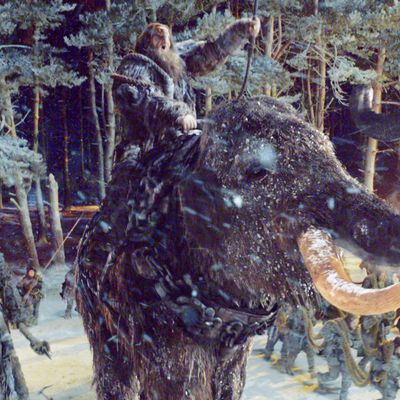
If you haven’t watched “The Watchers on the Wall,” the ninth episode of Game of Thrones’ fourth season, look away! Because there will be spoilers galore to follow, obviously.
It took more than 100 extras, two giants (real ones!), and tons of special effects to put together the epic throwdown between the men of the Night’s Watch and the legions of Free Folk in the latest episode of Game of Thrones. Neil Marshall, who directed season two’s “Blackwater” episode and its thrilling nautical battle, returned to helm “The Watchers on the Wall,” in which the wildlings, including the spurned Jon Snow paramour Ygritte, finally advanced on Castle Black. Following Sunday’s episode, Vulture spoke to Marshall about the massive half-hour brawl, which he filmed over three weeks last October. The director told us about working with actual giants, the special effect he saved just for Jon and Ygritte, and unleashing Kit Harrington.
Kit Harington said “The Watchers on the Wall” was the series’ most expensive yet. How does it compare to “Blackwater,” which reportedly cost $8 million to shoot?
Nobody ever tells me the budgets really. I’d guess that it might be more expensive. We had a lot more visual effects this time around, a lot more complicated visual effects. We had to build the same amount of sets I suppose. It probably is more expensive but nobody tells me the budgets. They only tell me how long I’ve got to shoot it.
Some of your earlier movies were probably less expensive than this.
Oh, yeah, lots. Dog Soldiers and The Descent were much less expensive than this. It’s probably on par with Centurion? [Editor’s note: The budget of Centurion is listed at $12 million.] The amount of extras, et cetera. But they were all [done] in five or six weeks.
How many days did you have to shoot this episode?
We had about four weeks in total. At least a week of that was spent in a green-screen studio doing motion control work, shooting the giants and stuff like that, which was very logistically complicated.
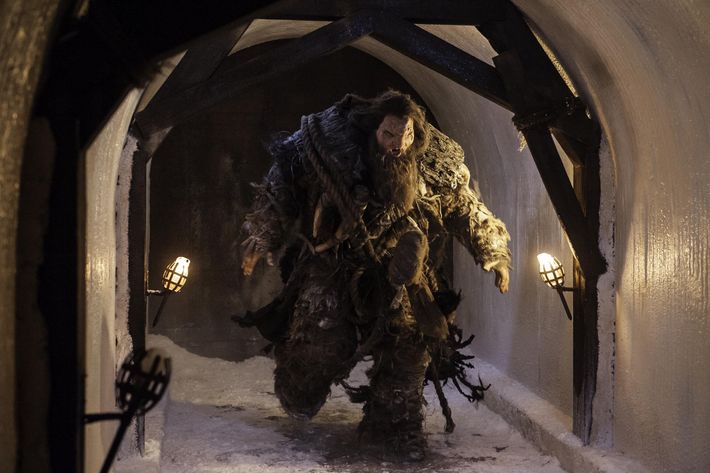
You had giants and mammoths. Was that all CG?
The only thing that’s not real is the mammoth itself, which is 100 percent CGI. The giants are both played by actors. One guy is like 7’5” and the other is maybe eight foot — he’s, like, the tallest man in Europe. They came in to the green-screen studio, we filmed them, and what we do is double them in size, basically. They’re 100 percent real, just bigger than normal.
What about when they’re riding the mammoth?
He’s real but we had a — what’s it called, the bucking bull things they have — a mechanical bull. We had a device that was like that but built on the saddle of a mammoth. He would get on top of that against green. The thing would go through all these riding motions and they’d add in the mammoth underneath him. That’s what made it so complex. It sounds quite simple but it’s really logistically time consuming.
The producers said there obviously isn’t a Wall either, so what went into having all the action set near something that exists?
We have a segment of wall. There’s a bit of ice wall in the studio we use for some shots and there’s a wall in the back of the Castle Black set. But everything else is fabricated, CG, or matte paintings. Then we have a set in the studio again for the top of the Wall. So everything involving the Wall is CGI somewhere. We had to build an entire new set on top of the wall. That was a huge set. We had the biggest backdrop in Europe created for this set. It’s absolutely huge. I’m sure I have the dimensions somewhere but I don’t have them on me. It’s well over 100 feet tall but I couldn’t tell you how wide it is. They made it at Pinewood Studios in London and it’s the biggest single piece they’ve probably ever made. The set itself had to be built 20 feet off the ground, so that we could get upward angles on all the guys on top of the wall. It was kind of a dangerous environment, very difficult to work in — there were ice trenches and things like that. But it looked spectacular.
Was the weather better than it was on “Blackwater”? I remember reading about the mud and rain on those night shoots.
Not really. It was all night shoots again in the same location as “Blackwater,” in the quarry. We had some torrential rain. One night the set literally flooded. I ended up standing on an apple box in a river basically trying to watch a monitor to see what the shots were. We just had to keep going.
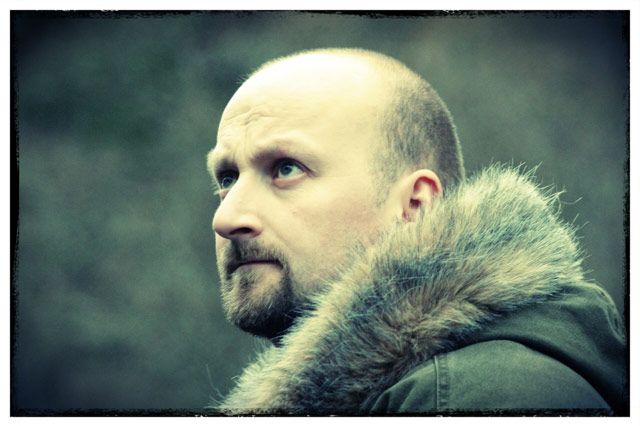
There’s an uninterrupted shot that happens three quarters of the way through the episode when Jon Snow comes down from the Wall and we follow all the fighting around the entire castle. What did that entail?
The first time I walked onto the Castle Black set, I noticed that it’s a 360-degree set. When you’re in the courtyard, you have the set all around you. I immediately thought I want to do a 360-degree crane shot of the battleground. And then I figured it should be linking all the characters together in a single shot, showing where they all are in an individual part of the battle. We rehearsed it for an hour, all the extras and the stunt guys and the camera. The camera on the crane was spinning around with such speed that if it had hit somebody it could have killed them. We did it in seven takes, and there’s no tricks there, it’s all one shot. We had a great AD team and a great stunt team and they worked it out in sections. Each section had a number and as the camera went around they’d call out a number and when they heard their number they’d start their action. When you break it down like that, it becomes a lot simpler, but still, there’s always the x factor of someone takes a step to the left and the camera hits them or something.
Also cool: When one of the giants shoots an arrow from the ground and hits the man of the Night’s Watch standing up on the Wall.
That was an idea to link all three locations together, from one side of the Wall to the other. And we shot it in three different locations! We shot the giant shooting the arrow in a field in front of a green screen. The guy on top of the Wall was on the set. He gets whipped off the Wall, and then we did a third piece at Castle Black where he lands. So we connected the dots.
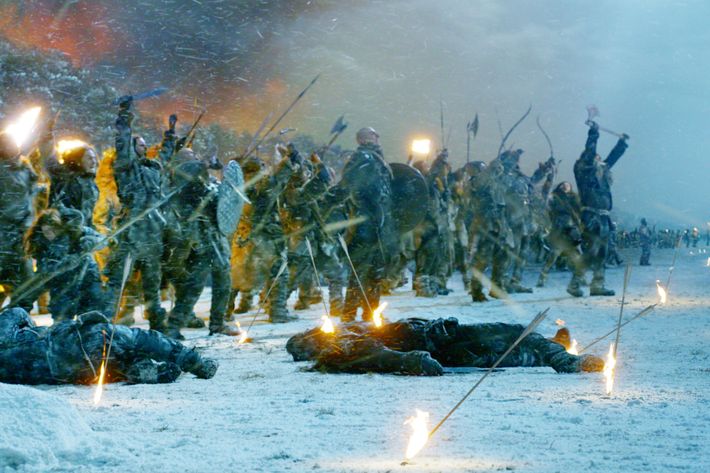
Talk about wrangling all those extras as they’re about to rush the Wall. How many were there?
Between 100 and 200, and they were great fun. They put up with some miserable conditions. If we’re spending the night on a very wet shoot, we’ve got raincoats and things like that on. If they’re dressed in furs and things like that, they just get soaked. But they all just keep coming back for more because they all love it so much. So when you get a scene like that and you have a hundred so of these guys and women all screaming and shouting and waving swords and really getting into it, it’s pretty phenomenal.
You chose to frame Jon and the late Ygritte in slow motion, which is not something you see a lot on Game of Thrones.
I wanted to separate them from the battle. If it was in regular speed without sound, it would seem weird. You do it slow motion and it puts them in a little bubble. It’s as much what’s going through Jon’s mind as anything. He’s not thinking about the battle right now, so we shouldn’t be either. It’s rare we use slow motion on the show at all. I saved it for that shot and that shot alone.
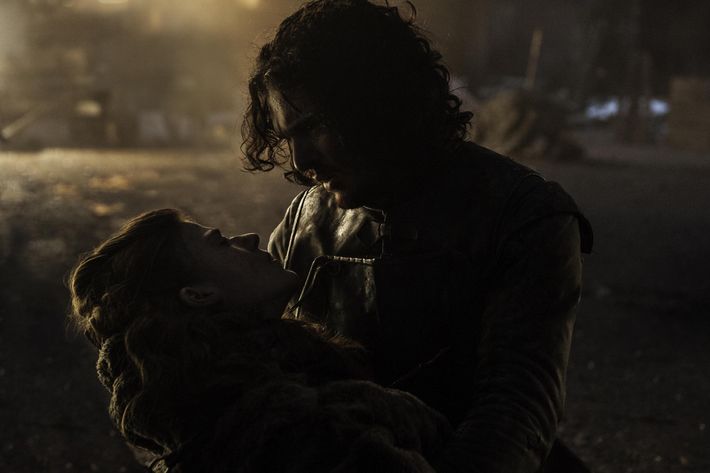
How did your experience on this one compare to your time on “Blackwater,” which you were called in at the last minute to do?
Well, I had a lot more prep time for sure. I only had a week’s prep on “Blackwater.” In that sense, I went in a lot better prepared. But it’s very similar. It was trying to come up with new and interesting ways to keep the action flowing, keep people involved so it doesn’t become repetitive, but also focus on the characters and the drama and not let these bigger elements drown that out. Game of Thrones is all about the characters. Honestly, though, it was mostly the same. Last time, I had a pretty big boat that didn’t exist. This time I had mammoths.
You also worked with a different cast of characters this time. Harrington is very much the anchor of the episode.
He worked really hard. He was doing weeks of fight choreography and rehearsals. After three seasons, it was like letting him out of the cage for the first time. We’ve seen his potential, little glimpses of what he’s capable of. But it was like suddenly unleashing the beast.
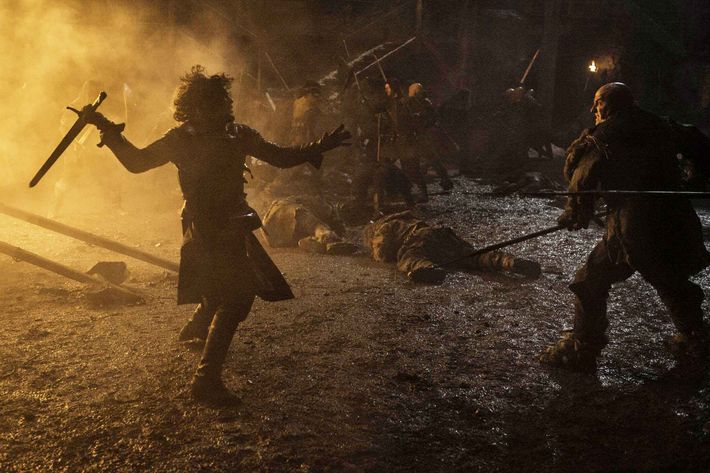
Was there anything you couldn’t shoot — either from the books or the original script — for budgetary reasons? Anything you needed to reconfigure?
Not that I’m aware of. I think there were things like the scythe that they come up with. I don’t even know if that’s in the books or not. I remember [showrunners David Benioff and D.B. Weiss] came up with this idea and there was pressure for them to cut it out. They stuck with it and I came up with how to do it — and I’m so glad they did stick with it because it looks awesome.
What made the scythe iffy?
It was about how it was going to practically work — where it was originating from, how did you release it, what did it look like, all that stuff had to make sense and that’s what I worked on. There were segments of chain that were real. The chain was huge, so a chain link was four feet long because the mouth of the blade itself is meant to be 16 foot tall or something like that. The blade never existed in reality but a lot of the rest did.
I noticed there wasn’t a nudity warning in the beginning of this episode like there is before so many episodes of the show. Two years ago, you mentioned an executive on set representing the “pervert side” of production. You didn’t have that this time. Looking back, do you feel like it was necessary in “Blackwater”?
I don’t think they’re gratuitous with the nudity on Game of Thrones. It’s very much part of the world. There’s a lot of it, but that’s the world they come from. It never is there to distract from the scene or the actors or story. I think the moment they stop the story to focus on nudity then, yeah, they’ll be doing the show some damage. But as long as it’s integral to the world, that’s fine. This one is the Night’s Watch, so there wasn’t anything like that going on here. I got to focus on the mayhem and chaos and slaughter.
At the time of “Blackwater,” you hadn’t read the books. Have you picked up the books since or watch the show religiously?
I’ve been watching the show as it progresses. I’ve been watching this season avidly. It’s the first season I’ve watched on a weekly basis, which is kind of punishing. In the past, I just got the DVD box set and binge-watched the whole thing. Watching it week by week is tough but it’s worth waiting for.

